Prof. Dr Jan Pajak THE NEW ZEALAND EXPLOSION OF ... - Totalizm
Prof. Dr Jan Pajak THE NEW ZEALAND EXPLOSION OF ... - Totalizm
Prof. Dr Jan Pajak THE NEW ZEALAND EXPLOSION OF ... - Totalizm
- No tags were found...
Create successful ePaper yourself
Turn your PDF publications into a flip-book with our unique Google optimized e-Paper software.
D-50Chapter D:EVIDENCE THAT <strong>THE</strong> TAPANUI <strong>EXPLOSION</strong>HAD GLOBAL CONSEQUENCESThe Tapanui explosion was so powerful that its reflection from the moon wasobserved as far away as England by a group of monks from Canterbury Cathedral. Thehistoric record of this observation approximately 810 years later has allowed for the precisedetermination of the date and hour when the Tapanui explosion took place.D1. A historic record of the Tapanui ExplosionThere is the record dated 18 June 1178 (Julian Calendar) and made by BrotherGervase, a Chronicler at Canterbury Cathedral (England). The popular presentation of thisrecord is contained in part 4: "Heaven and Hell" of the TV series by <strong>Dr</strong> Carl Sagan,Cosmos, and it is also published in the book [1D1] by Simon Welfare & John Fairley:"Arthur C. Clarke's Mysterious World", William Collins Ltd., London 1980, ISBN0-00-216536-8, page 184. The record describes the unusual visual distortions of the Moon'sappearance that was witnessed by a group of monks from the Canterbury Cathedral. Hereis this record, quoted from the above book:"In this year, on the Sunday before the feast of Saint John the Baptist, after sunsetwhen the moon had first become visible, a marvellous phenomenon was witnessed bysome five or more men who were sitting there facing the moon. Now there was a bright newmoon, and as usual in that phase, its horns were tilted towards the east and suddenly theupper horn split in two. From the midpoint of this division a flaming torch sprang up,spewing out, over a considerable distance, fire, hot coals and sparks. Meanwhile the bodyof the moon, which was below, writhed, as it were, in anxiety, and, to put it in the words ofthose who reported it to me and saw it with their own eyes, the moon throbbed like awounded snake. Afterwards it resumed its proper state. This phenomenon was repeated adozen times or more, the flame assuming various twisting shapes at random and thenreturning to normal. Then after these transformations the moon from horn to horn, that isalong its whole length, took on a blackish appearance."The author's interpretation of this observation is as follows. The flash of the firstvehicle that exploded over Tapanui was reflected from the moon like from a mirror.Simultaneously the magnetic shockwave of this explosion spread through the ionospherecausing the image of the moon to apparently writhe. The principle of this writhing is similarto that of disturbances of water waving the image of a motionless coin from under thesurface. After the first vehicle, the following vehicles from the cigar-shaped stack explodedin sequence, each of them causing a reflection of light, and shockwaves. When theexplosions ceased, a cloud of dust spread into the upper atmosphere gradually obstructingthe colour of the moon. Note, that during the Tunguska Explosion in 1908 the shockwavescirculated three times around our globe, and the dust sprays caused unusual atmosphericphenomena noticeable in many countries.It should be added here that there is also another interpretation of Gervase's record,made originally by <strong>Dr</strong> Jack B. Hartung of the State University of New York at Stony Brook,and published in his article in the Meteoritics, 30 September 1976 (11:187-94). Hartung'sinterpretation states that monks witnessed a meteorite impacting the moon on its blackside. A possible crater formed during that impact is the Giordano Bruno crater, discovered


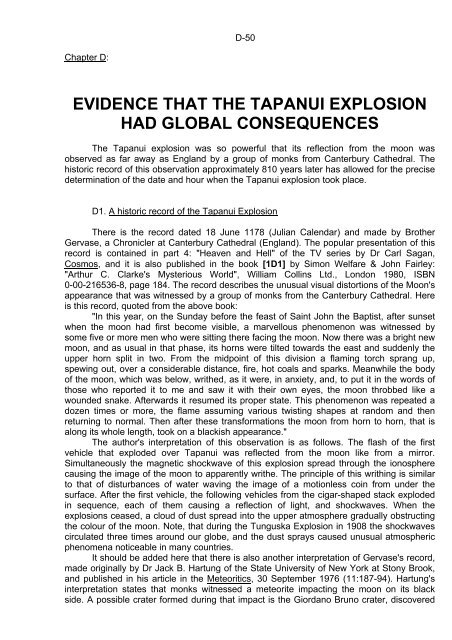
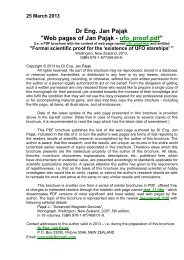


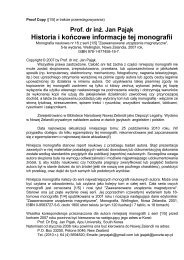
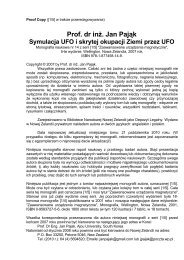
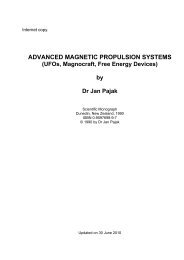
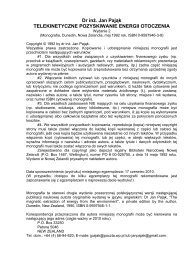
![[1/4p]: PDF - Totalizm](https://img.yumpu.com/45003232/1/184x260/1-4p-pdf-totalizm.jpg?quality=85)
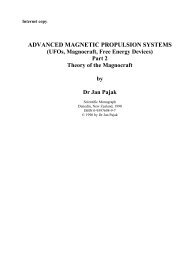
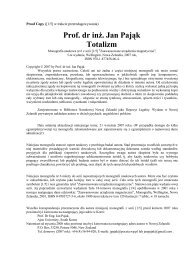
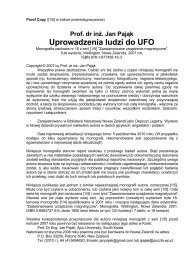
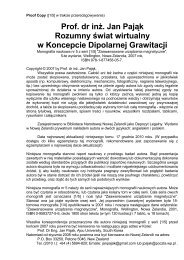
![[1/4p]: PDF - Totalizm](https://img.yumpu.com/39351336/1/184x260/1-4p-pdf-totalizm.jpg?quality=85)
